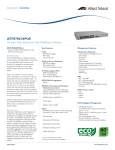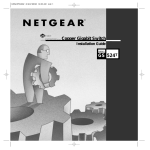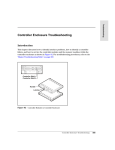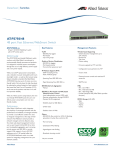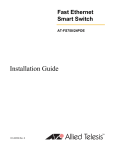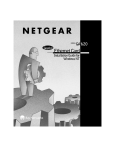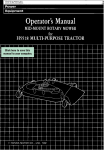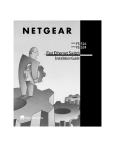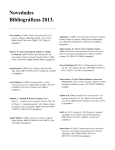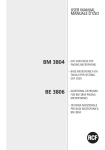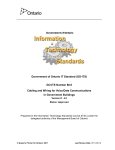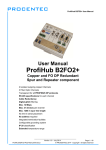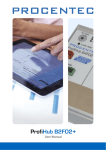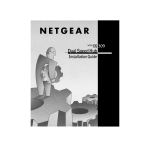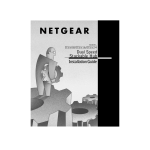Download Netgear FS 750 User's Manual
Transcript
Modular Fast Ethernet Switch User‘s Guide MODEL FS 726 MODEL FS 750 Trademarks NETGEAR® is a registered trademark of NETGEAR, Inc. in the United States and other countries. All other trademarks and registered trademarks are the property of their respective owners. Statement of Conditions In the interest of improving internal design, operational function, and/or reliability, NETGEAR reserves the right to make changes to the products described in this document without notice. NETGEAR does not assume any liability that may occur due to the use or application of the product(s) or circuit layout(s) described herein. Certificate of the Manufacturer/Importer It is hereby certified that the NETGEAR Model FS726 Modular Fast Ethernet Switch and Model FS750 Modular Fast Ethernet Switch have been suppressed in accordance with the conditions set out in the BMPTAmtsblVfg 243/1991 and Vfg 46/1992. The operation of some equipment (for example, test transmitters) in accordance with the regulations may, however, be subject to certain restrictions. Please refer to the notes in the operating instructions. Federal Office for Telecommunications Approvals has been notified of the placing of this equipment on the market and has been granted the right to test the series for compliance with the regulations. Voluntary Control Council for Interference (VCCI) Statement This equipment is in the first category (information equipment to be used in commercial and/or industrial areas) and conforms to the standards set by the Voluntary Control Council for Interference by Data Processing Equipment and Electronic Office Machines that are aimed at preventing radio interference in commercial and/or industrial areas. Consequently, when this equipment is used in a residential area or in an adjacent area thereto, radio interference may be caused to equipment such as radios and TV receivers. Federal Communications Commission (FCC) Compliance Notice: Radio Frequency Notice This device complies with part 15 of the FCC Rules. Operation is subject to the following two conditions: • This device may not cause harmful interference. • This device must accept any interference received, including interference that may cause undesired operation. Note: This equipment has been tested and found to comply with the limits for a Class A digital device, pursuant to part 15 of the FCC Rules. These limits are designed to provide reasonable protection against harmful interference in a residential installation. This equipment generates, uses, and can radiate radio fre- ii quency energy and, if not installed and used in accordance with the instructions, may cause harmful interference to radio communications. However, there is no guarantee that interference will not occur in a particular installation. If this equipment does cause harmful interference to radio or television reception, which can be determined by turning the equipment off and on, the user is encouraged to try to correct the interference by one or more of the following measures: • • • • Reorient or relocate the receiving antenna. Increase the separation between the equipment and receiver. Connect the equipment into an outlet on a circuit different from that which the receiver is connected. Consult the dealer or an experienced radio/TV technician for help. EN 55024 Declaration of Conformity This is to certify that the NETGEAR Model FS726 Modular Fast Ethernet Switch and Model FS750 Modular Fast Ethernet Switch are shielded against the generation of radio interference in accordance with the application of Council Directive 89/336/EEC, Article 4a. Conformity is declared by the application of EN 55024 Class A (CISPR 22). ! Warning: This is a Class A product. In a domestic environment, this product may cause radio interference, in which case the user may be required to take appropriate measures. Canadian Department of Communications Radio Interference Regulations These digital apparatuses (NETGEAR Model FS726 Modular Fast Ethernet Switch and Model FS750 Modular Fast Ethernet Switch) do not exceed the Class A limits for radio-noise emissions from digital apparatus as set out in the Radio Interference Regulations of the Canadian Department of Communications. Règlement sur le brouillage radioélectrique du ministère des Communications Ces appareils numériques (NETGEAR Model FS726 Modular Fast Ethernet Switch et Model FS750 Modular Fast Ethernet Switch) respectent les limites de bruits radioélectriques visant les appareils numériques de classe A prescrites dans le Règlement sur le brouillage radioélectrique du ministère des Communications du Canada. iii Customer Support For assistance with installing and configuring your NETGEAR system or with questions or problems following installation: • Check the NETGEAR Web page at http://www.NETGEAR.com. • Call Technical Support in North America at 1-888-NETGEAR. Our technicians are standing by to assist you 24 hours a day, 7 days a week.If you are outside North America, please refer to the phone numbers listed on the Support Information Card that shipped with your switch. • E-mail Technical Support at [email protected]. Defective or damaged merchandise can be returned to your point-of-purchase representative. Internet/World Wide Web NETGEAR maintains a World Wide Web home page that you can access at the uniform resource locator (URL) http://www.NETGEAR.com. A direct connection to the Internet and a Web browser such as Internet Explorer or Netscape are required. iv CONTENTS CHAPTER 1 Introduction Description Features Key Features Additional Features Package Contents 1-1 1-1 1-2 1-2 1-3 1-5 CHAPTER 2 Physical Description Front and Back Panels 10/100 Mbps RJ-45 Ports LED Mode Button and LED Descriptions Module Bays Auto Uplink Reset Button 2-1 2-1 2-3 2-4 2-5 2-5 2-7 CHAPTER 3 Applications Desktop Switching Segment Switching and Bridging from 10 Mbps to 100 Mbps Media Compatibility and Conversion 3-1 3-1 3-2 3-2 CHAPTER 4 Installation Preparing the Site Installing the Switch Installing the Switch on a Flat Surface Installing the Switch in a Rack Connecting Devices to the Switch Using Gigabit Ethernet Modules Checking the Installation Applying AC Power 4-1 4-2 4-3 4-3 4-3 4-4 4-5 4-6 4-6 Contents v CHAPTER 5 Troubleshooting Information Additional Troubleshooting Suggestions Network Adapter Cards Configuration Switch Integrity Auto Negotiation 5-1 5-3 5-3 5-3 5-3 5-3 APPENDIX A Technical Specifications Network Protocol and Standards Compatibility Data Rate Interface Performance Specifications Bandwidth Electrical Specifications Power Consumption Physical Specifications Environmental Specifications Electromagnetic Emissions Electromagnetic Susceptibility Safety Agency Approvals A-1 A-1 A-1 A-1 A-2 A-2 A-3 A-3 A-3 A-3 A-4 A-4 A-4 APPENDIX B Connector Pin Assignments RJ-45 Plug and RJ-45 Connector Duplex SC Plug and Duplex SC Connector B-1 B-1 B-3 contents vi APPENDIX C Cabling Guidelines Fast Ethernet Cable Guidelines Category 5 Cable Category 5 Cable Specifications Twisted Pair Cables Patch Panels and Cables Using 1000BASE-T Gigabit Ethernet over Category 5 Cable Overview Cabling Length Return Loss Near End Crosstalk (NEXT) Patch Cables Conclusion Fiber Optic Cables Fiber Cable Specifications Gigabit Cable Guidelines INDEX FIGURES C-1 C-1 C-2 C-3 C-3 C-5 C-5 C-5 C-6 C-6 C-6 C-7 C-7 C-7 C-8 C-8 C-8 I-1 contents vii Figure 1-1. Package Contents 1-5 Figure 2-1. Front and Back Panels of the FS726 Switch 2-2 Figure 2-2. Front and Back Panels of the FS750 Switch 2-3 Figure 2-3. Creating Redundant Paths between Network Devices (Example 1) 2-6 Figure 2-4. Creating Redundant Paths between Network Devices (Example 2) 2-6 Figure 3-1. Example of Desktop Switching 3-1 Figure 3-2. Example of Segment Switching and Bridging 3-2 Figure 3-3. Example of Media Compatibility and Conversion 3-3 Figure 4-1. Attaching Mounting Brackets 4-3 Figure 4-2. Connecting Devices to the Switch 4-4 Figure B-1. RJ-45 Plug and RJ-45 Connector with Built-in LEDs B-1 Figure B-2 B-3 Duplex SC Cconnector and Duplex SC Plug Figure C-1. Straight-Through Twisted-Pair Cable C-4 Figure C-2. Crossover Twisted-Pair Cable C-4 Figure C-3. Category 5 UTP Cable with Male RJ-45 Plug at Each End C-5 TABLES figures viii Table 1-1. Key Features 1-2 Table 2-1. Front Panel LEDs 2-4 Table 4-1. Site Requirements 4-2 Table 5-1. Troubleshooting Information 5-1 Table B-1. 10/100 Mbps RJ-45 Plug and RJ-45 Connector Pin Assignments B-2 Table B-2. 100/1000 Mbps RJ-45 Plug and RJ-45 Connector Pin Assignments B-2 Table C-1. Electrical Requirements of Category 5 Cable C-3 Table C-2. Electrical Requirements of Fiber Optic Cable C-8 Table C-3. Gigabit Cable Guidelines C-8 tables ix CHAPTER 1: INTRODUCTION This installation guide describes the NETGEAR FS726 and FS750 Modular Fast Ethernet Switches. NETGEAR’s FS726 and FS750 are expandable, high-performance, IEEE-compliant network switches designed for users who require a large number of ports and want the high-speed capability of 10/100 switching to eliminate bottlenecks, boost performance, and increase productivity. Both switches are designed with front module bays that will accommodate either copper gigabit modules or fiber gigabit modules for high-speed connection to a server or your network backbone. Built-in modularity gives you the flexibility to buy according to your immediate needs, then add to your system later. You can purchase the optimal combination of copper and fiber gigabit modules for your network – both the same or one of each, as either will function in each module bay. To simplify installation, both switch models are shipped ready for use, with no configuration required. Everything necessary for setup comes in the box. This chapter provides the following information: • Description • Features • Package contents Description NETGEAR’s FS726 and FS750 Modular Fast Ethernet Switches are flexible, powerful, and easy-to-use network solutions. Both switches have two front panel module bays that can be used with gigabit uplinks to create a high-performance backbone connection. Each module bay accepts either a copper Gigabit Ethernet module (1000BASE-T, introduction 1-1 NETGEAR Model AG711T) or a fiber Gigabit Ethernet module (1000BASE-SX, NETGEAR Model AG711F). (Modules are not included with the switches.) With the advantage of this modularity you can: • Connect switches to each other with high-speed links • Link up to high-speed servers • Connect fiber and copper networks The NETGEAR FS726 Switch provides 24 shielded RJ-45 network ports, while the NETGEAR FS750 Switch provides 48 shielded RJ-45 network ports. All RJ-45 ports on the FS726 and FS750 Switches automatically negotiate to the highest speed, making the switches ideal for environments that have a mix of Ethernet and Fast Ethernet devices. In addition, all 10/100 Mbps ports operate in half- or full-duplex mode, increasing the maximum bandwidth of each connection up to 20 Mbps or 200 Mbps, respectively. Both switch models support automatic address learning and IEEE 802.3x-compliant flow control to ensure optimal packet reliability. The FS726 and FS750 Switches can be free-standing or rack mounted in a wiring closet or equipment room. Features The following sections describe the characteristics of NETGEAR’s FS726 and FS750 Switches. Key Features Table 1-1 summarizes the key features of the FS726 and FS750 Switches. Table 1-1. Key Features: Feature FS726 Switch FS750 Switch Number of 10/100 Mbps RJ-45 ports per switch: 24 48 Number of module bays per switch: 2 2 introduction 1-2 Additional Features The FS726 and FS750 Switches share the following features: • Uplink adaptability for either copper gigabit or fiber gigabit modules • Auto UplinkTM to automatically configure the RJ-45 ports for use with either straight-through or crossover cables to make the right connection • Non-blocking, wire-speed filtering and forwarding of the traffic on all ports • Scalability to meet your growing network needs, enabling performance to keep pace with port density • High-speed bandwidth over uplink connections • Easy Plug-and-Play installation with no software to configure, for quick and easy connection to new or existing 10 and 100 Mbps users and services • Store-and-forward intelligent processing to remove erroneous packets from the network • Automatic address-learning function to build the packet-forwarding information table. The table contains up to 8,000 media access control (MAC) addresses (that is, the switch can support networks with as many as 8,000 devices). • Link speed auto-sensing (10 or 100 Mbps) and duplex mode auto-sensing (half- or full-duplex) to optimize connectivity and allow companies to migrate to Fast Ethernet one port at a time • Full-duplex mode to double throughput of point-to-point connections by enabling individual ports to transmit and receive data concurrently • IEEE 802.3x-compliant flow control to prevent dropped packets due to network back-ups and bottlenecks introduction 1-3 • Compliance with the IEEE802.3i Ethernet, IEEE802.3u Fast Ethernet standards, IEEE802.3ab Gigabit Ethernet, and IEEE802.3z Gigabit Ethernet. • LED indicators to show link, speed, activity, collision, and duplex for switch status and troubleshooting. • Rack Mount Kit for installing the switch in a standard 19-inch equipment rack introduction 1-4 Package Contents Figure 1-1 shows the package contents of the FS726 and FS750 switches. Model FS726 or Model FS750 Switch (Model FS726 shown) Rubber footpads AC power cord Rack-mount kit Installation Guide Warranty Owner Registration Card Support Information Card Figure 1-1. Package Contents Verify that your package contains the following: • FS726 or FS750 Switch • Rubber footpads for tabletop installation • Power cord • Rack-mount kit for installing the switch in a 19-inch rack • NETGEAR FS726 and FS750 Modular Fast Ethernet Switch User’s Guide • Support Information Card • Warranty & Owner Registration Card If any item is missing or damaged, contact your place of purchase immediately. introduction 1-5 CHAPTER 2: PHYSICAL DESCRIPTION This chapter describes the hardware features of the FS726 and FS750 Switches. Topics include: • Front and back panels • 10/100 Mbps RJ-45 ports • LED Mode button and LEDs • Module bays (for copper or fiber Gigabit Ethernet modules) • Auto Uplink • Reset button Front and Back Panels Figure 2-1 shows the key components on the front and back panels of the FS726 Switch. Figure 2-2 shows the key components on the front and back panels of the FS750 Switch. The front panel of each switch contains a reset button, an LED Mode push button for alternating LED readout categories, Link LEDs, Mode LEDs, RJ-45 jacks, and two module bays for installing Gigabit Ethernet modules. Both the FS726 Switch and the FS750 Switch support Auto Uplink technology, eliminating the need for a Normal/Uplink push button. The back panel of each switch has fans for cooling, and a standard AC power receptacle for accommodating the supplied power cord. physical description 2-1 Front Panel of the Model FS726 Switch Link LEDs Mode LEDs 10/100 Mbps ports Module Bays Power LED LED Mode Button Reset Button Rear Panel of the Model FS726 Switch Fan Figure 2-1. Front and Back Panels of the FS726 Switch physical description 2-2 Power Receptacle Front Panel of the Model FS750 Switch 10/100 Mbps ports Link LEDs Module Bays Mode LEDs Power LED LED Mode Button Reset Button Rear Panel of the Model FS750 Switch Figure 2-2. Front and Back Panels of the FS750 Switch 10/100 Mbps RJ-45 Ports As Figures 2-1 and 2-2 show, the FS726 Switch has 24 RJ-45 ports, while the FS750 Switch has 48 RJ-45 ports. These are auto-sensing 10/100 Mbps ports: when you insert a cable into an RJ-45 port, the switch automatically detects the maximum speed (10 or 100 Mbps) and duplex mode (half- or full-duplex) of the attached device, and displays this information using the front panel 100 Mbps and FDX LEDs for that port (LEDs are described in the next section). The 10/100 Mbps ports support only unshielded twisted-pair (UTP) cable terminated with an 8-pin RJ-45 plug. physical description 2-3 LED Mode Button and LED Descriptions LEDs on the front panels of the FS726 and FS750 Switches provide a quick and accurate display of port operation. Users can clearly identify the status of each port for link and by toggling the LED Mode button through the associated categories speed, activity, collision, and duplex mode . Table 2-1 summarizes the LEDs on the FS726 and FS750 Switches. A detailed description of the LEDs follows the table. Table 2-1. Front Panel LEDs Label Color Activity Description Power Green Off On Power is supplied to the switch. Power is disconnected Link Green Off On Port has a valid link connection. A valid link has not been established on the port. Mode in: Max Spd 10/100 Mbps Port Green On Off Port has made a 100 Mbps connection. Port has made a 10 Mbps connection. Module Bay Port Green On Off Port has a valid 1000 Mbps (1 Gbps) link connection A valid link has not been established on the port. Green Blinking Data transmission is occurring on the port. Yellow Blinking Data collision is occurring on the port. The rate at which this LED blinks corresponds to the number of collisions. When a collision occurs, the connected device pauses and transmits again after waiting a specified time. Green On Port is operating in full-duplex mode. Yellow On Port is operating in half-duplex mode. Mode in: Activity / Collision Mode in: FDX physical description 2-4 Module Bays Two module bays on both switches allow you to upgrade as you go, whether you need gigabit uplink or additional port capacity. Each module bay will accept either a copper Gigabit Ethernet module (1000BASE-T, NETGEAR Model AG711T) or a fiber Gigabit Ethernet module (1000BASE-SX, NETGEAR Model AG711F) for high-speed connection to a server, to connect fiber and copper networks, or to extend your network backbone with high-speed links. Auto Uplink To simplify the procedure for attaching devices, all RJ-45 ports on the FS726 and FS750 Switches support Auto Uplink. This technology allows you to attach devices to the RJ-45 ports using either straight-through or crossover cables. When you insert a cable into the switch’s RJ-45 port, the switch automatically: • Senses whether the cable is a straight-through or crossover cable, and • Determines whether the link to the attached device requires a "normal" connection (such as when connecting the port to a PC) or an "uplink" connection (such as when connecting the port to a router, switch, or hub). After detecting this information, the switch automatically configures the RJ-45 port to enable communications with the attached device, without requiring user intervention. In this way, the Auto Uplink technology compensates for setting uplink connections, while eliminating concern about whether to use crossover or straight-through cables when attaching devices. Note: Using Auto Uplink to create multiple active paths between any two network devices can cause undesirable loops in the network, resulting in an endless broadcast traffic that disables your network. Loops occur when there are alternate routes between two network devices. In Figure 2-3, for example, a loop is created by connecting two RJ-45 ports on an FS726 Switch to a router containing a 4-port switch. Figure 2-4 shows another scenario where a router with a 4-port switch connects to a hub and to a FS726 Switch; the hub and switch, in turn, connect back to the same router, creating multiple active paths between all three devices. physical description 2-5 Model FS726 Switch FR314 Router Figure 2-3. Creating Redundant Paths between Network Devices (Example 1) Model FS726 Switch EN524 Hub FR314 Router Figure 2-4. Creating Redundant Paths between Network Devices (Example 2) physical description 2-6 Reset Button A reset button is located on the front panels of the FS726 and FS750 Switches. The button allows you to reinitialize the switches after you either insert or remove a module from a module bay. To activate the Reset button, insert a small wire, such as a paper clip, into the hole and gently push. As the switch reinitializes, all of the LEDs will extinguish, then light up for approximately one second during the self-test, and then return to their normal state. The switch will then operate as normal with the new bay configuration. physical description 2-7 CHAPTER 3: APPLICATIONS The FS726 and FS750 Switches are designed to provide flexibility in configuring your network connections. Both switches can be used as stand-alone devices or used with 10 Mbps hubs, 100 Mbps hubs, or 10/100 Mbps switches. This chapter shows how the FS726 and FS750 Switches can be used in various network environments. Topics include: • Desktop switching • Segment switching and bridging from 10 Mbps to 100 Mbps • Media compatibility and conversion Desktop Switching The FS726 and FS750 Switches can be used as desktop switches to build a small network that enables users to have 1000 Mbps access to a file server. A full-duplex adapter card installed in the server can provide 2000 Mbps full-duplex connection. 1000 Mbps 100 Mbps 10 Mbps Server Server Model FS726 Switch Model FS750 Switch Figure 3-1. Example of Desktop Switching applications 3-1 Segment Switching and Bridging from 10 Mbps to 100 Mbps The FS726 and FS750 Switches can be used to segment a network into multiple connected pieces to increase overall bandwidth and throughput. Both switch models can segment networks that are built with the NETGEAR DS508 and EN516 hubs, and can act as bridges connecting traditional 10BASE-T Ethernet networks to 100BASE-TX Fast Ethernet networks. Model FS726 Switch Model DS508 Hub Model FR314 Router Model EN516 Hub Figure 3-2. Example of Segment Switching and Bridging Media Compatibility and Conversion The FS726 and FS750 Switches are ideal for a mixed media environment. Both switches feature two front panel module bays that can be easily installed with one or two fiber Gigabit Ethernet modules, one or two copper Gigabit Ethernet modules, or one gigabit module of each type, providing optimal flexibility for high-speed connection to a server or your network backbone. applications 3-2 Model FS726 Model FS509 Model FS518 MODEL Ethernet 10/100Mbps 1 Fast Ethernet Switch 2 3 10 11 4 5 6 7 8 17 15 16 18 1 00M Green=FDX,Yellow+COL Activity with Gigabit Ports Power 9 12 13 MODEL Switching Activity 18 PORT 14 4 10M 8 5 9PORT 10/100Mbps 1000M Normal/Uplink Green = FDX,Yellow = COL FS518T 17 On = Link Fast Ethernet Switch 100M 1 10M 2 3 4 5 Power 1 2 3 4 5 6 7 8 On = Link Normal/Uplink Rx/Tx 100M 6 7 8 Tx FS509 Rx 1000M Link 9 1 9 13 12 16 18 Green = FDX, Yellow = COL Figure 3-3. Example of Media Compatibility and Conversion applications 3-3 CHAPTER 4: INSTALLATION This chapter describes the installation procedures for the NETGEAR FS726 and FS750 Switches. Topics include: • Preparing the site • Installing the switch • Connecting devices to the switch • Checking the installation • Applying AC power installation 4-1 Preparing the Site Before you install your switch, be sure your operating environment meets the operating environment requirements in Table 4-1. Table 4-1. Site Requirements Characteristics Requirements Mounting Desktop installations: Provide a flat table or shelf surface. Rack-mount installations: Use a 19-inch (48.3-centimeter) EIA standard equipment rack that is grounded and physically secure. You also need the rack-mount kit supplied with your switch. Access Locate the switch in a position that lets you access the front panel RJ-45 ports, view the front panel LEDs, and access the rear-panel stacking port(s) and power connector. Power source Provide a power source within 6 feet (1.8 meters) of the installation location. Power specifications for the switches are shown in Appendix A. Be sure the AC outlet is not controlled by a wall switch, which can accidentally turn off power to the outlet and the switch. Environmental Install the switch in a dry area, with ambient temperature between 0 and 40ºC (32 and 104ºF). Keep the switch away from heat sources such as direct sunlight, warm air exhausts, hot-air vents, and heaters. Temperature: Operating humidity: The installation location should have a maximum relative humidity of 90%, non-condensing. Ventilation: Do not restrict airflow by covering or obstructing air inlets on the sides of the switch. Keep at least 2 inches (5.08 centimeters) free on all sides for cooling. Be sure there is adequate airflow in the room or wiring closet where you intend to install the switch. Operating conditions: Keep the switch at least 6 ft (1.83 m) away from nearest source of electro magnetic noise, such as a photocopy machine. After confirming that your site meets the requirements in Table 4-1, you are ready to install the switch. installation 4-2 Installing the Switch You can install the NETGEAR FS726 and FS750 Switches on a flat surface or in a standard 19-inch rack. Installing the Switch on a Flat Surface 1. The switch ships with four self-adhesive rubber footpads. Affix one rubber footpad on each of the four concave spaces on the bottom of the switch. The rubber footpads cushion the switch against shock/vibrations. MODEL Figure 4-1. Attaching Mounting Brackets Installing the Switch in a Rack To install the FS726 or FS750 Switch in a rack, use the following procedure (and refer to Figure 4-1). To perform this procedure, you need the 19-inch rack-mount kit supplied with your switch. 1. Attach the supplied mounting brackets to the side of the switch. 2. Insert the screws provided in the rack-mount kit through each bracket and into the bracket mounting holes in the switch. 3. Tighten the screws with a #1 Phillips screwdriver to secure each bracket. 4. Align the mounting holes in the brackets with the holes in the rack, and insert two pan-head screws with nylon washers through each bracket and into the rack. 5. Tighten the screws with a #2 Phillips screwdriver to secure the switch in the rack. 6. Proceed to "Connecting Devices to the Switch." installation 4-3 Connecting Devices to the Switch The following procedure describes how to connect devices to the switch’s RJ-45 ports. When attaching devices to an FS726 or an FS750, the switch’s support for Auto Uplink technology allows you to attach devices using either straight-through or crossover cables (for more information about Auto Link‘ technology, refer to "Auto Uplink " on page 12). 7. Connect each device to an RJ-45 network port on the switch’s front panel (see Figure 4-2). Use Category 5 (Cat5) unshielded twisted-pair (UTP) cable terminated with an RJ-45 connector to make these connections. Front Panel of the Model FS726 or Model FS750 Switch (Model FS726 shown) Figure 4-2. Connecting Devices to the Switch Note: Ethernet specifications limit the cable length between the switch and the attached device to 100 m (328 ft). installation 4-4 Using Gigabit Ethernet Modules The modularity of the FS726 and 750 Switches provides you with a highly adaptable network.. You not only can configure your network for copper and/or fiber gigabit uplinks, but you also can opt to expand your network gradually and affordably, as needed. Installing a Gigabit Ethernet module: a. Unscrew and remove the module cover plate. b. Insert the module into the slot, pressing firmly to seat the module. c. Tighten the module screws. d. Press the reset button if the power has remained on throughout the installation of the gigabit modules. installation 4-5 Checking the Installation Before you apply power: • Inspect the equipment thoroughly. • Verify that all cables are installed correctly. • Check cable routing to make sure cables are not damaged or create a safety hazard. • Be sure all equipment is mounted properly and securely. Applying AC Power The switches do not have an ON/OFF switch; the only method of applying or removing AC power is by connecting or disconnecting the power cord. Before you connect the power cord, select an AC outlet that is not controlled by a wall switch, which can turn off power to the switch. After you select an appropriate outlet, use the following procedure to apply AC power. 8. Connect the female end of the supplied AC power adapter cable to the power outlet on the back of the switch 9. Connect the 3-pronged end of the AC power adapter cable to a grounded 3-pronged AC outlet. When you apply power: • The green Power LED on the switch’s front panel goes on. • The green Link LED on each connected RJ-45 port goes on. If the green Power LED does not go on, check that the power cable is plugged in correctly and that the power source is good. If this does not resolve the problem, refer to Chapter 5, Troubleshooting. When power is applied, the switch conducts a power-on self-test (POST) to verify operation. After the switch passes the POST, it is functional and ready to pass data. installation 4-6 installation 4-7 CHAPTER 5: TROUBLESHOOTING This chapter provides guidance in troubleshooting the NETGEAR FS726 and FS750 Switches. Information includes: • Troubleshooting information table • Additional troubleshooting suggestions Troubleshooting Chart Table 5-1 lists symptoms, causes, and solutions of possible problems. Table 5-1. Troubleshooting Chart Symptom Cause Solution Power LED is off. No power is received Check the power cord connections for the switch at the switch. and the connected device. Make sure all cables used are correct and comply with Ethernet specifications. Link LED is off or intermittnet. Port connection is not working Check the crimp on the connectors and make sure that the plug is properly inserted and locked into the port at both the switch and the connecting device. Make sure all cables used are correct and comply with Ethernet specifications. See Appendix C. Check for a defective adapter card, cable, or port by testing them in an alternate environment where all products are functioning. troubleshooting 5-1 Symptom Cause Solution Link LED is off for a port that has a connection. There is a problem with this connection. Make sure the cable is attached securely at both ends. Make sure the cable is not damaged. Check that the device being connected to is powered on and operating correctly. If the connection is to a workstation, make sure the workstation’s network interface is installed and configured correctly. File transfer is slow or performance degradation is a problem. Half- or full-duplex setting on the switch and the connected device are not the same. Make sure the attached device is set to auto negotiate. A segment or device is not recognized as part of the network. One or more devices are not properly connected, or cabling does not meet Ethernet guidelines. Verify that the cabling is correct. Be sure all connectors are securely positioned in the required ports. Equipment may have been accidentally disconnected. ACT LED is blinking yellow excessively. Collisions are occurring on the connected segment. Some collisions are normal when the connection is operating in half-duplex mode. Duplex modes are mismatched. Recheck the settings of the device attached to the RJ-45 port. Make sure the attached device is set to auto negotiate. A network loop (redundant path) has been created (see Figures 2-3 and 2.4). Break the loop by ensuring that there is only one path from any networked device to any other networked device. ACT LED is flashing continuously on all connected ports and the network is disabled troubleshooting 5-2 Additional Troubleshooting Suggestions If the suggestions in Table 5-1 do not resolve your problem, refer to the troubleshooting suggestions in this section. Network Adapter Cards Make sure the network adapter cards installed in the PCs are in working condition and the software driver has been installed. Configuration If problems occur after altering the network configuration, restore the original connections and determine the problem by implementing the new changes, one step at a time. Make sure that cable distances, repeater limits, and other physical aspects of the installation do not exceed the Ethernet limitations. Switch Integrity If required, verify the integrity of the switch by resetting the switch. To reset the switch, remove AC power from the switch and then reapply AC power. If the problem continues, contact NETGEAR technical support. In North America, call 1-888-NETGEAR. If you are outside of North America, please refer to the support information card included with your product. Auto Negotiation The 10/100 Mbps ports negotiate the correct duplex mode and speed if the device at the other end of the link supports auto negotiation. If the device does not support auto negotiation, the switch only determines the speed correctly and the duplex mode defaults to half-duplex. installation 5-3 APPENDIX A: TECHNICAL SPECIFICATIONS This appendix provides technical specifications for the NETGEAR FS726 or FS750 Switches. Network Protocol and Standards Compatibility ISO/IEC 802-3i 10BASE-T IEEE 802.3u 100BASE-TX IEEE 802.3ab 1000BASE-T IEEE 802.3z 1000BASE-SX IEEE 802.3x Flow Control Data Rate 10 Mbps differential Manchester encoded, IEEE 802.3 100 Mbps with 4B/5B encoding and MLT-3 physical interface for 100BASE-TX 1000 Mbps with 8B/10B encoding PAM-5 physical interface for 1000BASE-T Interface RJ-45 connector for 10BASE-T, 100BASE-TX Fast Ethernet, and 1000BASE-T Gigabit Ethernet 1000 Mbps Duplex SC fiber connector for 62.5/125 or 50/125 multimode fiber (1000BASE-SX) technical specifications A-1 Performance Specifications Frame filter rate: 14,800 frames/second, maximum on 10 Mbps port (64B packets) 148,000 frames/second, maximum on 100 Mbps port (64B packets) 1,480,000 frames/second, maximum on 1000 Mbps port (64B packets) Frame forward rate: 14,800 frames/second, maximum on 10 Mbps port (64B packets) 148,000 frames/second, maximum on 100 Mbps port (64B packets) 1,480,000 frames/second, maximum on 1000 Mbps port (64B packets) 10/100 buffer memory: 8 MB for 16 ports Gigabit buffer memory: 2 BM per port Forwarding modes: Store-and-forward Network latency: Less than 80 microseconds for 64-byte frames in store-andforward mode for 10 Mbps to 100 Mbps transmission Address database size: 8,000 media access control (MAC) addresses per system Addressing: 48-bit MAC address Acoustic noise: (ANSI-S10.12) FS726 45 dB FS750 52dB Heat Dissipation: FS726 18.99 Btu/hr FS750 12.06 Btu/hr Bandwidth: FS726 5 Gbps FS750 8 Gbps technical specifications A-2 Electrical Specifications Power Consumption: FS726 40W maximum FS750 60W maximum Physical Specifications Dimensions: Weight: FS726 W 440 mm (17.3") D 205 mm (8.1") H 43 mm (1.6") 3.2 Kg (7.0 lbs) FS750 W 440 mm (17.3") D 205 mm (8.1") H 86 mm (3.4") 4.3 Kg (9.5 lbs) Environmental Specifications Operating temperature: 0 to 40°C Storage temperature: -32 to 104°C Operating humidity: 90% maximum relative humidity, noncondensing Storage humidity: 95% maximum relative humidity, noncondensing Operating altitude: 10,000 ft (3,000 m) maximum Storage altitude: 10,000 ft (3,000 m) maximum technical specifications A-3 Electromagnetic Emissions Meets requirements of: CE mark, commercial FCC Part 15, Subpart B, Class A EN 55024 (CISPR 22), Class A VCCI Class 1A C-tick Electromagnetic Susceptibility CE mark, commercial Electrostatic discharge (ESD): IEC 801-2, Level 2/3 Radiated electromagnetic field: IEC 801-3, Level 2 Electrical fast transient/burst: IEC 801-4, Level 2 Electrical surge: IEC 801-5, Level 1/2 Safety Agency Approvals CE mark, commercial UL/cUL listed (UL 1950) CSA certified (CSA 22.2 #950) TUV licensed (EN 60 950) technical specifications A-4 APPENDIX B: CONNECTOR PIN ASSIGNMENTS This appendix provides information about the RJ-45 plug and the RJ-45 connector used for the NETGEAR FS726 and FS750 Switches. RJ-45 Plug and RJ-45 Connector In a Fast Ethernet network, it is important that all 100BASE-T certified Category 5 cabling use RJ-45 plugs. The RJ-45 plug accepts 4-pair UTP or shielded twisted-pair (STP) 100 ohm cable and connects into the RJ-45 connector. The RJ-45 connector is used to connect stations, hubs, and switches through UTP cable; it supports 10 Mbps, 100 Mbps, or 1000 Mbps data transmission. Figure B-1 shows the RJ-45 plug and RJ-45 connector. 12345678 8 Key: 1 to 8 = pin numbers 1 711EA Figure B-1. RJ-45 Plug and RJ-45 Connector with Built-in LEDs connector pin assignments B-1 Table B-1 lists the pin assignments for the 10/100 Mbps RJ-45 plug and the RJ-45 connector. Table B-1. 10/100 Mbps RJ-45 Plug and RJ-45 Connector Pin Assignments Pin Normal Assignment Uplink Assignment 1 Input Receive Data + Output Transmit Data + 2 Input Receive Data – Output Transmit Data – 3 Output Transmit Data + Input Receive Data + 6 Output Transmit Data – Input Receive Data – 4, 5, 7, 8 Internal termination, not used for data transmission Table B-2 lists the pin assignments for the 10/100/1000 Mbps RJ-45 plug and the RJ-45 connector. B-2. 10/100/1000 Mbps RJ-45 Plug and RJ-45 Connector Pin Assignments Pin Channel Description 1 2 A Rx/Tx Data + Rx/Tx Data 3 6 B Rx/Tx Data + Rx/Tx Data 4 5 C Rx/Tx Data + Rx/Tx Data 7 8 D Rx/Tx Data + Rx/Tx Data connector pin assignments B-2 Duplex SC Plug and Duplex SC Connector The duplex SC connector connects stations, hubs, and switches that support the 1000BASE-SX fiber interface. Each fiber link needs a clearly defined, external crossover. In other words, the transmit port of one interface must be wired to the receive port of the opposite interface and vice versa. Fiber cables must be connected in this manner to transmit and receive data. The duplex SC connector and duplex SC plug are illustrated in Figure B-2. TX RX 8895FA Figure B-2. Duplex SC Connector and Duplex SC Plug Connection ! Warning: Fiber optic equipment can emit laser or infrared light that might injure your eyes. Never look into an optical fiber or connector port. Always assume that fiber optic cables are connected to a light source. connector pin assignments B-3 APPENDIX C: CABLING GUIDELINES This appendix provides specifications for cables used with the FS726 and FS750 Switches. Fast Ethernet Cable Guidelines Fast Ethernet uses UTP cable, as specified in the IEEE 802.3u standard for 100BASE-TX. The specification requires Category 5 UTP cable consisting of either two-pair or fourpair twisted insulated copper conductors bound in a single plastic sheath. Category 5 cable is certified up to 100 MHz bandwidth. 100BASE-TX operation uses one pair of wires for transmission and the other pair for receiving and for collision detection. When installing Category 5 UTP cabling, use the following guidelines to ensure that your cables perform to the following specifications: • Certification Make sure that your Category 5 UTP cable has completed the Underwriters’ Laboratories (UL) or Electronic Testing Laboratories (ETL) certification process. • Termination method To minimize crosstalk noise, maintain the twist ratio of the cable up to the point of termination; untwist at any RJ-45 plug or patch panel should not exceed 0.5 inch (1.5 cm). cabling guidelines C-1 Category 5 Cable Category 5 distributed cable that meets ANSI/EIA/TIA-568-A building wiring standards can be a maximum of 328 feet (ft) or 100 meters (m) in length, divided as follows: • 20 ft (6 m) between the hub and the patch panel (if used) • 295 ft (90 m) from the wiring closet to the wall outlet • 10 ft (3 m) from the wall outlet to the desktop device The patch panel and other connecting hardware must meet the requirements for 100 Mbps operation (Category 5). Only 0.5 inch (1.5 cm) of untwist in the wire pair is allowed at any termination point. cabling guidelines C-2 Category 5 Cable Specifications Table C-1 lists the electrical requirements of Category 5 UTP cable. Table C-1. Electrical Requirements of Category 5 Cable Specifications Category 5 Cable Requirements Number of pairs Four Impedance 100 Ω ± 15% Mutual capacitance at 1 KHz ≤5.6 nF per 100 m Maximum attenuation (dB per 100 m, at 20° C) NEXT loss (dB minimum) at 4 MHz: 8.2 at 31 MHz: 11.7 at 100 MHz: 22.0 at 16 MHz: 44 at 31 MHz: 39 at 100 MHz: 32 Twisted Pair Cables For two devices to communicate, the transmitter of each device must be connected to the receiver of the other device. The crossover function is usually implemented internally as part of the circuitry in the device. Computers and workstation adapter cards are usually media-dependent interface ports, called MDI or uplink ports. Most repeaters and switch ports are configured as media-dependent interfaces with built-in crossover ports, called MDI-X or normal ports. Auto UplinkTM automatically senses which connection, MDI or MDI-X, is needed and makes the right connection. cabling guidelines C-3 Figure C-1 illustrates straight-through twisted pair cable. 1 1 2 2 Rx Tx A B 3 3 6 6 Rx Tx 736EA Key: A = Uplink or MDI port (as on a PC) B = Normal or MDI-X port (as on a hub or switch) 1, 2, 3, 6 = Pin numbers Figure C-1. Straight-Through Twisted-Pair Cable Figure C-2 illustrates crossover twisted pair cable. 1 1 2 2 Rx Rx B B Tx 3 3 6 6 Tx Key: B = Normal or MDI-X port (as on a hub or switch) 1, 2, 3, 6 = Pin numbers Figure C-2. Crossover Twisted-Pair Cable cabling guidelines C-4 737EA Patch Panels and Cables If you are using patch panels, make sure that they meet the 100BASE-TX requirements. NETGEAR recommends Category 5 UTP cable for all patch cables and work area cables to ensure that your UTP patch cable rating meets or exceeds the distribution cable rating. To wire patch panels, you need two Category 5 UTP cables with an RJ-45 plug at each end, as shown in Figure C-3. 1 2 1 87654321 87654321 Figure C-3. Category 5 UTP Cable with Male RJ-45 Plug at Each End Note: Flat “silver satin” telephone cable may have the same RJ-45 plug. However, using telephone cable results in excessive collisions, causing the attached port to be partitioned or disconnected from the network. Using 1000BASE-T Gigabit Ethernet over Category 5 Cable Overview When using the new 1000BASE-T standard, the limitations of cable installations and the steps necessary to ensure optimum performance must be considered. The most important components in your cabling system are patch panel connections, twists of the pairs at connector transition points, the jacket around the twisted-pair cable, bundling of multiple pairs on horizontal runs and punch down blocks. All of these factors affect the performance of 1000BASE-T technology if not correctly implemented. The following sections are designed to act as a guide to correct cabling for 1000BASE-T. cabling guidelines C-5 Cabling The 1000BASE-T product is designed to operate over Category 5 cabling. To further enhance the operation, the cabling standards have been amended. The latest standard is Category 5e, which defines a higher level of link performance than is available with Category 5 cable. If installing new cable, we recommend using Category 5e cable, since it costs about the same as Category 5 cable. If using the existing cable, be sure to have the cable plant tested by a professional who can verify that it meets or exceeds either ANSI/EIA/TIA568-A:1995 or ISO/IEC 11801:1995 Category 5 specifications. Length The maximum distance limitation between two pieces of equipment is 100 m, as per the original Ethernet specification. The end-to-end link is called the "channel." TSB-67 defines the "Basic Link" which is the portion of the link that is part of the building infrastructure. This excludes patch and equipment cords. The maximum basic link length is 295 feet (90 m). Return Loss Return loss measures the amount of reflected signal energy resulting from impedance changes in the cabling link. The nature of 1000BASE-T renders this measurement very important; if too much energy is reflected back on to the receiver, the device does not perform optimally. Unlike 10BASE-T and 100BASE-TX, which use only two of the four pairs of wires within the Category 5, 1000BASE-T uses all four pairs of the twisted pair. Make sure all wires are tested — this is important. cabling guidelines C-6 Factors that affect the return loss are: • The number of transition points, as there is a connection via an RJ-45 to another connector, a patch panel, or device at each transition point. • Removing the jacket that surrounds the four pairs of twisted cable. It is highly recommended that, when RJ-45 connections are made, this is minimized to 1-1/4 inch (32 mm). • Untwisting any pair of the twisted-pair cabling. It is important that any untwisting be minimized to 3/8 inch (10 mm) for RJ-45 connections. • Cabling or bundling of multiple Category 5 cables. This is regulated by ANSI/EIA/TIA-568A-3. If not correctly implemented, this can adversely affect all cabling parameters. Near End Cross Talk (NEXT) This is a measure of the signal coupling from one wire to another, within a cable assembly, or among cables within a bundle. NEXT measures the amount of crosstalk disturbance energy that is detected at the near end of the link — the end where the transmitter is located. NEXT measures the amount of energy that is "returned" to the sender end.The factors that affect NEXT and crosstalk are exactly the same as outlined in the Return Loss section.The crosstalk performance is directly related to the quality of the cable installation. Patch Cables When installing your equipment, replace old patch panel cables that do not meet Category 5e specifications. As pointed out in the NEXT section, this near end piece of cable is critical for successful operation. Conclusion For optimum performance of your 1000BASE-T product, it is important to fully qualify your cable installation and ensure it meets or exceeds ANSI/EIA/TIA-568-A:1995 or ISO/IEC 11801:1995 Category 5 specifications. Install Category 5e cable where possible, including patch panel cables. Minimize transition points, jacket removal, and untwist lengths. Bundling of cables must be properly installed to meet the requirements in ANSI/EIA/TIA-568A-3. cabling guidelines C-7 Fiber Optic Cables In North America, use EIA-569-A horizontal 62.5/125 µm multimode optical fiber cable (ANSI/EIA/TIA-492AAAA). Internationally, use ISO/IEC 11801 62.5/125 µm multimode optical fiber cable (IEC 793-2 type A1b, with 1.0db/km attenuation and 500 MHz/km bandwidth). Refer to Table C-2 for the minimum requirements of fiber optic cable. Fiber Cable Specifications Table C-2 lists the electrical requirements of fiber cable. Table C-2. Electrical Requirements of Fiber Optic Cable Specification Fiber Optic Cable Number of strands Two Cable type 62.5/125 µm multimode fiber optic cable Numerical aperture 0.275 Total link budget 11 db Modal band 500 MHz/km Zero dispersion wavelength 1295 to 1365 nm Dispersion slope < 0.093 ps/nm 2 -km Gigabit Cable Guidelines Table C-3 lists the distance limitations for Gigabit fiber connections. Table C-3. Gigabit Cable Guidelines Multimode Fiber 62.5/125-Micron 50/125-Micron Operating Range 2 to 260 meters 2 to 550 meters cabling guidelines C-8 A Applications Desktop Switching, 3-1 Segment Switching and Bridging from Mbps to 100 Mbps, 3-2 Applying AC Power, 4-6 Auto Uplink, 2-5 Features, 1-2 Front and Back Panels, 2-1 Fiber Optic Cables, C-8 Fiber Cable Specifications, C-8 G Gigabit Cable Guidelines, C-8 C I Cabling guidelines Fast Ethernet Cable Guidelines, C-1 Category 5 Cable, C-2 Category 5 Cable Specifications, C-3 Twisted Pair Cables, C-3 Patch Panels and Cables, C-5 Using 1000BASE-T Gigabit Ethernet over Category 5 Cable, C-5 Cabling, C-6 Length, C-6 Return Loss, C-6 Near End Cross Talk (NEXT), C-7 Patch Cables, C-7 Conclusion, C-7 Checking the Installation, 4-6 Connecting Devices to the Switch, 4-4 Connector pin assignments RJ-45 Plug and RJ-45 Connector, B-1 Customer Support, iv Installation Preparing the Site, 4-2 Installing the Switch, 4-3 Installing the Switch on a Flat Surface, 4-3 Installing the Switch in a Rack, 4-3 Connecting Devices to the Switch, 4-4 Checking the Installation, 4-6 Applying AC Power, 4-6 Interface, A-1 D L LED Descriptions, 2-4 N Near End Cross Talk (NEXT), C-7 Network Protocol and Standards Compatibility, A-1 Data Rate, A-1 Desktop Switching, 3-1 F Fast Ethernet Cable Guidelines, C-1 index I-1 P T Package Contents, 1-5 Patch Panels and Cables, C-5 Physical Description Front and Back Panels, 2-1 10/100 Mbps RJ-45 Ports, 2-3 LED Descriptions, 2-4 Module Bays, 2-5 Auto Uplink, 2-5 Preparing the Site, 4-2 Technical Specifications Network Protocol and Standards Compatibility, A-1 Data Rate, A-1 Interface, A-1 Electrical Specifications, A-3 Physical Specifications, A-2 Environmental Specifications, A-3 Electromagnetic Emissions, A-4 Electromagnetic Susceptibility, A-4 Safety Agency Approvals, A-4 Performance Specifications, A-2 Troubleshooting Troubleshooting Chart, 5-1 Additional Troubleshooting Suggestions, 5-3 Network Adapter Cards, 5-3 Configuration, 5-3 Switch Integrity, 5-3 Auto Negotiation, 5-3 Twisted Pair Cables, C-3 R Return Loss, C-6 RJ-45 Plug and RJ-45 Connector, B-1 S Segment Switching and Bridging from 10Mbps to 100 Mbps, 3-2 index I-2 NETGEAR, Inc. 4500 Great America Parkway Santa Clara, CA 95054 USA Phone: 1-888-NETGEAR www.NETGEAR.com M-FS700NA-0 July 2001






















































